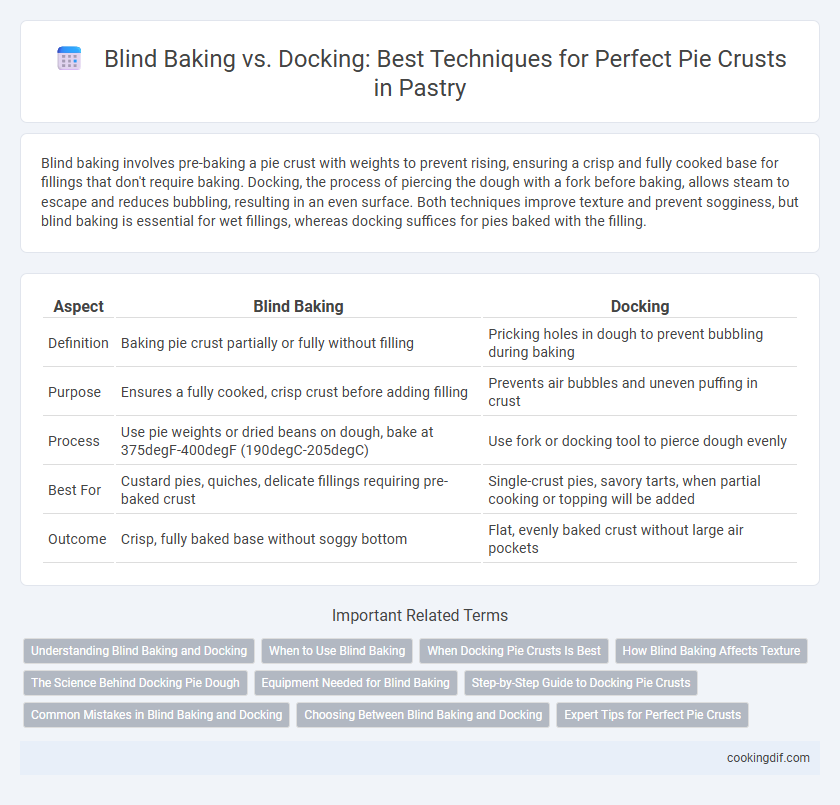Blind baking involves pre-baking a pie crust with weights to prevent rising, ensuring a crisp and fully cooked base for fillings that don't require baking. Docking, the process of piercing the dough with a fork before baking, allows steam to escape and reduces bubbling, resulting in an even surface. Both techniques improve texture and prevent sogginess, but blind baking is essential for wet fillings, whereas docking suffices for pies baked with the filling.
Table of Comparison
| Aspect | Blind Baking | Docking |
|---|---|---|
| Definition | Baking pie crust partially or fully without filling | Pricking holes in dough to prevent bubbling during baking |
| Purpose | Ensures a fully cooked, crisp crust before adding filling | Prevents air bubbles and uneven puffing in crust |
| Process | Use pie weights or dried beans on dough, bake at 375degF-400degF (190degC-205degC) | Use fork or docking tool to pierce dough evenly |
| Best For | Custard pies, quiches, delicate fillings requiring pre-baked crust | Single-crust pies, savory tarts, when partial cooking or topping will be added |
| Outcome | Crisp, fully baked base without soggy bottom | Flat, evenly baked crust without large air pockets |
Understanding Blind Baking and Docking
Blind baking involves pre-baking the pie crust without filling, using pie weights or dried beans to prevent puffing and ensure a crisp base. Docking refers to piercing the dough with a fork to allow steam to escape during baking, reducing bubbles and shrinkage. Both techniques ensure a well-cooked, flaky crust essential for custard or cream pies.
When to Use Blind Baking
Blind baking is essential for pie crusts with wet fillings like custards or fruit to prevent a soggy bottom by partially or fully baking the crust before adding the filling. Docking, which involves pricking the dough to allow steam to escape, is useful for pie crusts baked with dry fillings or when a crisp, evenly baked base is desired without the risk of puffing. Use blind baking when the recipe calls for a fully baked crust before filling, especially for delicate fillings that do not require baking themselves.
When Docking Pie Crusts Is Best
Docking pie crusts is best when baking delicate or flaky pastries where venting steam is essential to prevent bubbling and cracking. This technique involves piercing the dough with a fork to create small holes that allow steam to escape evenly during baking. Docking is ideal for custard pies, tarts, or quiches, where the crust needs to remain flat and crisp without the weight of blind baking materials.
How Blind Baking Affects Texture
Blind baking creates a crisp and firm pie crust by pre-baking the dough before adding the filling, preventing sogginess often caused by wet ingredients. Using baking weights or beans during blind baking maintains the crust's shape and ensures even cooking. This method results in a flaky, golden base with a desirable crunchy texture that docking alone cannot achieve.
The Science Behind Docking Pie Dough
Docking pie dough involves piercing the crust with small holes to allow steam to escape, preventing air pockets and uneven bubbling during baking. This technique helps maintain a flat and crisp crust by controlling moisture and pressure buildup within the pastry layers. Unlike blind baking, which uses weights to keep the dough flat, docking relies on creating venting points that ensure even heat distribution and texture consistency.
Equipment Needed for Blind Baking
Blind baking pie crusts requires essential equipment such as pie weights, ceramic or metal baking beans, and parchment paper to prevent the crust from puffing up during baking. A pie dish or tart pan with removable bottoms is preferred to ensure even heat distribution and easy removal. Using these tools helps achieve a crisp and well-set crust essential for custard or cream pies.
Step-by-Step Guide to Docking Pie Crusts
Docking pie crusts involves pricking the dough with a fork before baking to prevent air bubbles and ensure an even, flat surface. Start by rolling out the dough, fitting it into the pie pan, and trimming excess edges. Use a fork to create evenly spaced holes across the entire crust, then proceed with baking or blind baking as required by the recipe.
Common Mistakes in Blind Baking and Docking
Common mistakes in blind baking include failing to properly weigh down the crust, causing uneven puffing or shrinking during baking. In docking, over- or under-pricking the dough can lead to improper venting, resulting in soggy or cracked crusts. Ensuring even pie crust thickness and using appropriate baking times are essential to avoid these common pitfalls for flaky, crisp results.
Choosing Between Blind Baking and Docking
Choosing between blind baking and docking for pie crusts depends on the filling and desired texture; blind baking ensures a fully cooked, crisp crust ideal for custard or cream pies, while docking prevents bubbling and maintains a tender, flaky base suitable for fruit or single-crust pies. Blind baking involves pre-baking the crust with weights to avoid shrinking, creating a firm barrier against wet fillings. Docking uses a fork to pierce the dough, allowing steam to escape and reducing puffing without firming the crust excessively.
Expert Tips for Perfect Pie Crusts
Blind baking involves pre-baking a pie crust with pie weights or beans to prevent puffing and ensure a crisp base, while docking uses a fork to puncture the dough, allowing steam to escape and preventing bubbles. Experts recommend blind baking for wet fillings to avoid sogginess and docking for dry fillings to promote even baking. Combining both techniques can enhance texture and prevent crust shrinkage, resulting in a perfectly baked pie base.
Blind baking vs Docking for pie crusts Infographic

 cookingdif.com
cookingdif.com